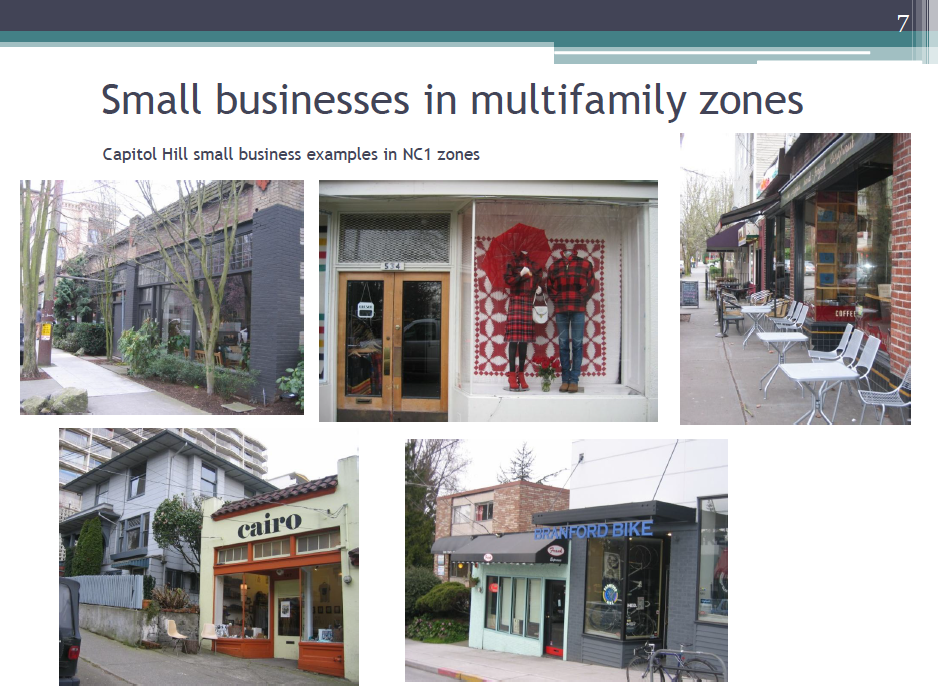 Examples of existing “small commercial” on Capitol Hill from a City presentation
Examples of existing “small commercial” on Capitol Hill from a City presentation
City planners are looking to ease concerns about mixed-use development trickling into Capitol Hill’s residential neighborhoods by reducing the size of the businesses that would be allowed to open in multifamily zones and possibly restricting the small commercial developments to arteries such as 12th Ave.
Wednesday’s session of the City Council’s land use committee will continue the process to overhaul Seattle’s development and planning regulations as committee members return to shaping the Regulatory Reform package, a sprawling set of legislation we first reported on here: Seattle ‘Regulatory Reform’ could push mixed-use deeper into Capitol Hill
While the reform package is a citywide set of updates to zoning laws and regulations, some of the elements focused on areas near transit stations and within official “urban centers” apply singularly to Capitol Hill.
The City Council held a public hearing on the Regulatory Reform package late last month.
“We’ve got feedback that some people are nervous about some of the things that might happen in those areas,” the City Council’s Richard Conlin said at Monday night’s meeting of the East District Neighborhood Council in the Cal Anderson Park Shelter House.
Following those concerns that the introduction of commercial projects into multifamily zones could erode the residential nature of some areas of the Hill and that the changes would further damage existing commercial areas like Broadway, the committee Wednesday will consider amendments to move the commercial element forward while reducing the potential damage some are concerned about.
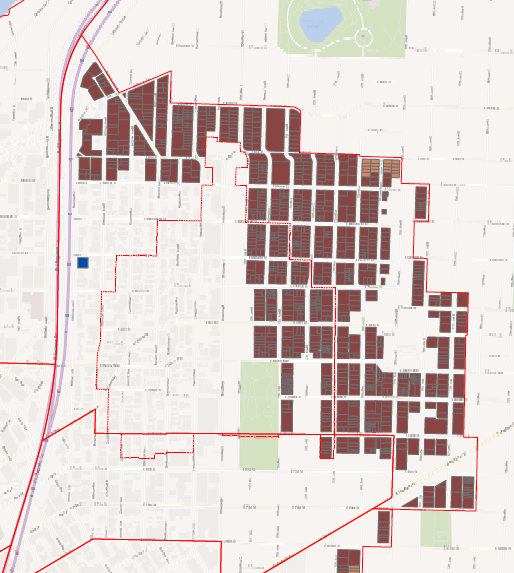 The area of Capitol Hill where the new zoning would apply — View Full Map (PDF)
The area of Capitol Hill where the new zoning would apply — View Full Map (PDF)
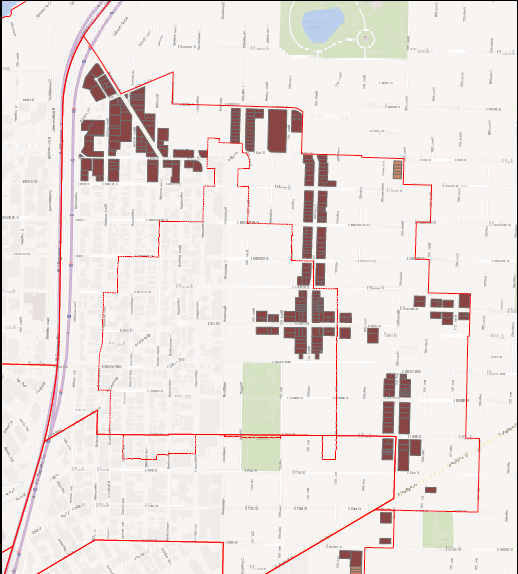 The area where the zoning would apply if restricted to arterials — View Full Map (PDF)
The area where the zoning would apply if restricted to arterials — View Full Map (PDF)
Changes to the initial proposals are likely to include a reduction in the allowed size for the commercial space in the multifamily buildings in qualifying areas. According to City Council staff working on the legislation, the original limit of 2,500 square feet could be reduced to 1,500 square feet. Conlin says DPD analysis shows that a 1,500 square-foot limit would still provide a viable commercial space.
There may also be effort to reshape the mixed-use changes so that they are restricted to multifamily zones along major streets, restricting the commercial allowance from the quieter edges of the multifamily areas.
The committee will also consider an even tighter set of restrictions on the nature of the allowed business types in these new multifamily commercial zones. Sorry — your idea for a neighborhood batting cage is probably going to be nixed.
Regardless of what comes out of Wednesday’s session, the reform package is too weighty for everything to be nailed down so quickly. The Council committee is reserving its discussion on the two most controversial — and complicated — aspects of the plan for a session in May. At that time, they’ll tackle the reform package’s attempt to cut back Seattle’s application of State Environmental Protection Action review and, yes, the proposal to remove minimum parking requirements on new residential developments within 1,300 feet of frequent transit service.
The sticky wicket on parking, we were told by one hopeful City Hall staffer, is sorting out exactly what “frequent” means. It seems likely, however, that the debate will be much more complicated than that. With the Seattle Times editorial board on one side, the other side is starting to extend beyond lifted minimums to restricted maximums. As CHS commenter ZefWagner said in his reply to Liz Dunn’s comments on the Melrose and Pine development situation:
I’m normally in favor of simply eliminating parking requirements rather than instituting maximums, but this case is causing me to rethink that policy. The problem is many developers are either accustomed to building in areas that need lots of parking, or the banks and other lenders require parking out of some belief that the project will be unsuccessful otherwise. Anyone who knows this area knows that very very little parking is necessary. Within a 15-minute walking distance residents could access most of downtown, south lake union, capitol hill, and first hill. Plus there are lots of amenities right in the immediate area. Add in multiple bus lines and close access to streetcar and light rail, plus decent bicycle access, and you have a perfect site for near-zero parking. If the cost and logistics of building two levels of underground parking is what is causing the need to level the buildings rather than rehab and add onto them, then the parking is what the community should focus on.
“It may be that there isn’t a legislative or regulatory way to approach this,” Conlin said Monday night about the parking issue and the banks and developers’ willingness to continue including expensive parking structures in their plans. “It really is getting them to understand the culture.”
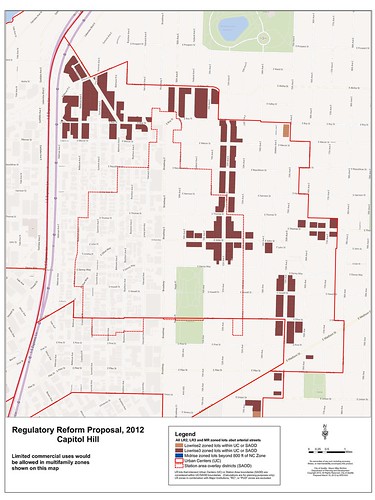




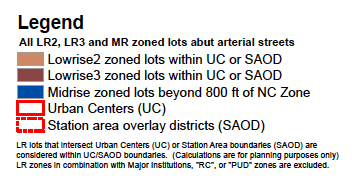
Parking maximums is an interesting idea but I’d be a bit wary of it personally. For one, I think a maximum isn’t necessarily going to change the opinions of banks and other lenders, so the result won’t be less parking, just less development. For some, that could actually be the goal, but if so, then just be explicit about that and landmark the neighborhood. Also, if lifting parking minimums is considered too much by some, I’m not sure its politically worthwhile to fight for parking maximums.
The changes to the mixed-use reform all seem like reasonable compromises but I do take issue with the complaints that more options for small business will “erode existing commercial centers”.
Remember that the current commercial strips are really just anachronisms from planning done many decades ago. There could actually be better places for commercial centers that would benefit more people, but we do not allow these opportunities to come about. Capitol Hill isn’t necessarily the best example, but in many places, like Ballard, people may actually prefer businesses along a quieter street rather than the loud and busy arterials. Allowing businesses to change and adapt to a shifting market should ultimately produce a more pleasant city for everyone.
Along these same lines, not all businesses benefit from high visibility (especially in this technological age). When we arbitrarily force all businesses to compete for only arterial frontage property, inevitably businesses that want high visibility outbid the ones that don’t. The result is a more homogenous retail mix. This is apparent in…
read more
ke/Pine where art galleries and theaters were pushed out by bars, restaurants, and high-end retail. Art galleries and theaters often don’t need to be in highly visible areas because they attract patrons through other means. Providing more opportunities on quieter streets might keep more of these arts businesses on the Hill.
Thanks, JSeattle, for your coverage of this issue. The long-term implications for this proposal (say, 20 years) is to completely destroy the residential neighborhoods between Broadway and 16th, wrapping around to the north to abut the historic district. My own view is that it makes sense to limit the proposal to arterials (to keep the traffic down) but to allow live-work situations (not just “artists” but any other residential living and working spaces). If the use were limited to the residents (no auxiliary workers except in child care programs) it would probably reflect what is already happening slowly over time, and would incubate very small start-ups without tempting developers to create new housing with allowed shop spaces (at a new space cost). This would also not compete with the already existing retail and office space now empty in new development.
I couldn’t agree more. Arterials are where MOST businesses belong. And people ARE already working out of their homes. Some give piano lessons, some sew, some cook for others. I am a real estate agent and hardly ever go to the office. I can do it all at home. Last year I sold a house vacationing on Lopez Island using a borrowed laptop. Even the Mayor and City Council must work from home. Most everyone I know works at home to some extent. It isn’t anything new.
I think trying to hold on to an artificial and outdated system of purely residential neighborhoods will only result in the decay of quality of the neighborhood. If you want to live in a suburb, move to Dallas. The quality of life on Capitol Hill stems from the vibrant street life and walkability, and relieving the restrictions that create residential only neighborhoods will help the area grow and mature as one of the best neighborhoods in the country.
I agree with Josh’s thoughts on parking and business location. As a young designer, I look forward to opening a small firm and will neither be able to afford a “premium” location nor want to have an office in a place where I can be a part of the community. If Seattle is to continue to be a example of a great American city, we need to relax antiquated zoning that prohibit urban growth.